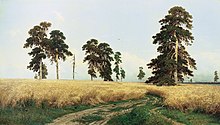Rye
| Rye | |
|---|---|

| |
| Scientific classification | |
| Kingdom: | |
| Division: | |
| Class: | |
| Order: | |
| Family: | |
| Subfamily: | |
| Tribe: | |
| Genus: | |
| Species: | S. cereale
|
| Binomial name | |
| Secale cereale | |
Rye (Secale cereale) is a grass grown extensively as a grain and forage crop. It is a member of the wheat tribe (Triticeae) and is closely related to barley and wheat. Rye grain is used for flour, rye bread, rye beer, some whiskies, some vodkas, and animal fodder. It can also be eaten whole, either as boiled rye berries, or by being rolled, similar to rolled oats.
Rye is a cereal and should not be confused with ryegrass which is used for lawns, pasture, and hay for livestock.
History
Rye is one of a number of species that grow wild in central and eastern Turkey, and adjacent areas. Domesticated rye occurs in small quantities at a number of Neolithic sites in Turkey, such as PPNB Can Hasan III, but is otherwise virtually absent from the archaeological record until the Bronze Age of central Europe, c. 1800-1500 BC.[1] It is possible that rye travelled west from Turkey as a minor admixture in wheat, and was only later cultivated in its own right. Although archeological evidence of this grain has been found in Roman contexts along the Rhine Danube and in the British Isles, Pliny the Elder is dismissive of rye, writing that it "is a very poor food and only serves to avert starvation" and wheat is mixed into it "to mitigate its bitter taste, and even then is most unpleasant to the stomach" (N.H. 18.40).
Since the Middle Ages, rye has been widely cultivated in Central and Eastern Europe and is the main bread cereal in most areas east of the French-German border and north of Hungary.
Claims of much earlier cultivation of rye, at the Epipalaeolithic site of Tell Abu Hureyra in the Euphrates valley of northern Syria, remain controversial. Critics point to inconsistencies in the radiocarbon dates, and identifications based solely on grain, rather than on chaff.
Agronomy

Rye, alone or overseeded, is planted as a livestock forage or harvested for hay. It is highly tolerant of soil acidity and is more tolerant of dry and cool conditions than wheat, though not as tolerant of cold as barley. In Turkey, rye is often grown as an admixture in wheat crops. It is appreciated for the flavour it brings to bread, as well as its ability to compensate for wheat's reduced yields in hard years.
The flame moth, rustic shoulder-knot and turnip moth are among the species of Lepidoptera whose larvae feed on rye.
Production and consumption statistics
| Top Ten Rye Producers — 2005 (million metric ton) | |
|---|---|
| 3.6 | |
| 3.4 | |
| 2.8 | |
| 1.2 | |
| 1.1 | |
| 0.6 | |
| 0.4 | |
| 0.3 | |
| 0.2 | |
| 0.2 | |
| World Total | 13.3 |
| Source: UN Food & Agriculture Organisation (FAO)[2] | |
Diseases
Rye is highly susceptible to the ergot fungus. Consumption of ergot-infected rye by humans and animals results in a serious medical condition known as ergotism. Ergotism can cause both physical and mental harm, including convulsions, miscarriage, necrosis of digits, and hallucinations. Historically, damp northern countries that have depended on rye as a staple crop were subject to periodic epidemics of this condition. There have been "occurrence[s] of ergotism with periods where there were high incidents of people persecuted for being witches. Emphasis was placed on the Salem witch trials in Massachusetts in 1692, where there was a sudden rise in the number of people accused of being witches, but earlier examples were taken from Europe, as well."[3]
Uses


Rye bread, including pumpernickel, is a widely eaten food in Northern and Eastern Europe. Rye is also used to make the familiar crisp bread. Rye flour has a lower gluten content than wheat flour, and contains a higher proportion of soluble fiber.
Some other uses of rye include rye whiskey and use as an alternative medicine in a liquid form, known as rye extract. Often marketed as Oralmat, rye extract is a liquid obtained from rye and similar to that extracted from wheatgrass. Its benefits are said to include a strengthened immune system, increased energy levels and relief from allergies, but there is no clinical evidence for its efficacy.
Rye straw is used to make corn dollies.
See also
References
- ^ Daniel Zohary and Maria Hopf, Domestication of plants in the Old World, third edition (Oxford: University Press, 2000), p. 75
- ^ Major Food And Agricultural Commodities And Producers - Countries By Commodity
- ^ Ergot of Rye: History
- "Secale cereale". Integrated Taxonomic Information System. September 22.
{{cite web}}: Check date values in:|date=and|year=/|date=mismatch (help) - " Multilingual taxonomic information". University of Melbourne.
External links
- Gordon Hillmann: New evidence of Lateglacial cereal cultivation at Abu Hureyra on the Euphrates, in: The Holocene 11/4 (July 2001), p. 383-393.
- Growing Rye hosted by the UNT Government Documents Department
- Rye recipes
| Minerals | ||
|---|---|---|
| Template:Calcium | 33 mg | |
| Template:Iron | 2,67 mg | |
| Template:Magnesium | 121 mg | |
| Template:Phosphorus | 374 mg | |
| Template:Potassium | 264 mg | |
| Template:Sodium | 6 mg | |
| Template:Zinc | 3,73 mg | |
| Template:Copper | 0,450 mg | |
| Template:Magnesium | 2,680 mg | |
| Template:Selenium | 0,035 mg | |
This food ingredient article is a stub. You can help Wikipedia by expanding it. |
